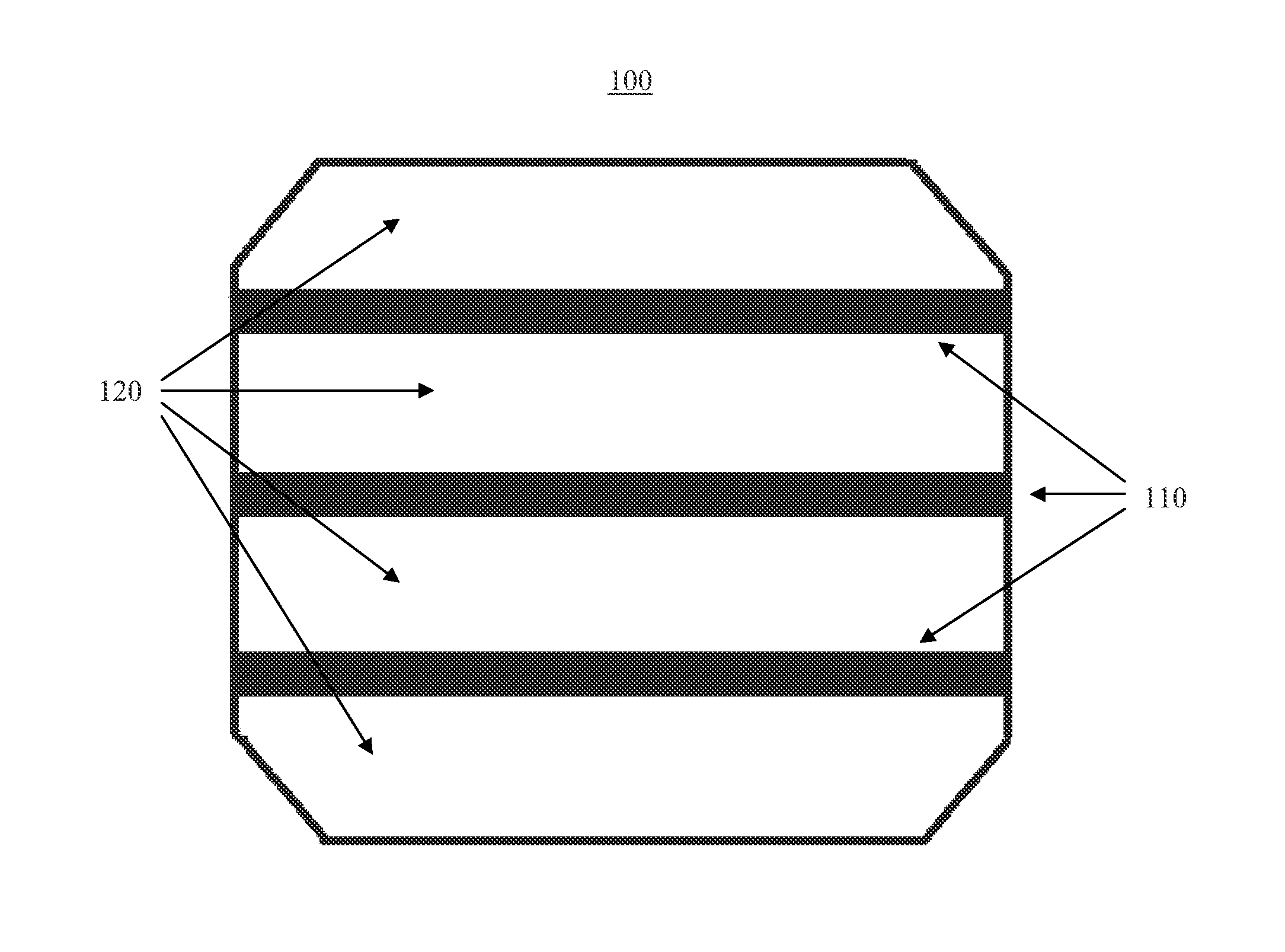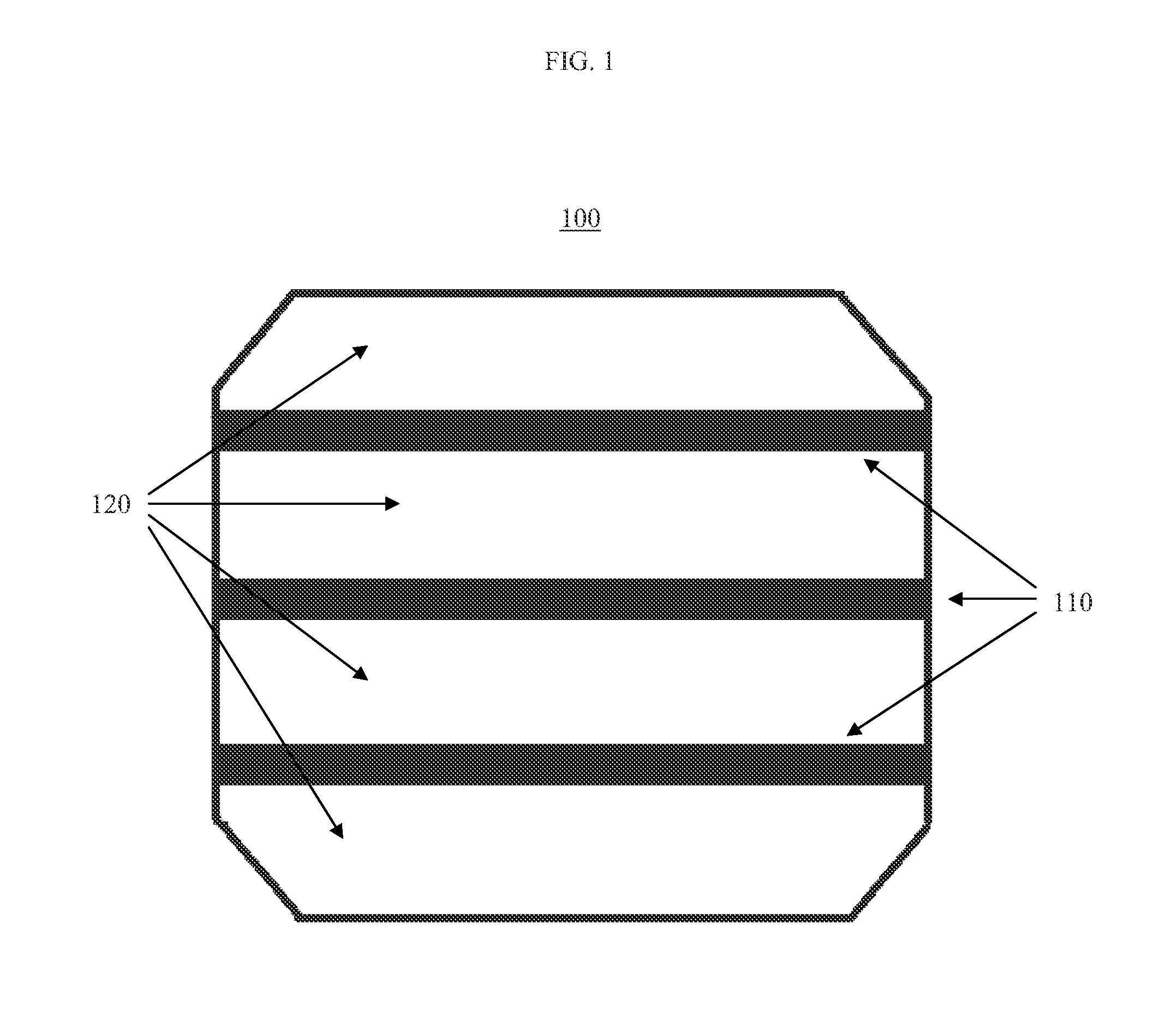Electroconductive paste with adhesion enhancer
- Summary
- Abstract
- Description
- Claims
- Application Information
AI Technical Summary
Benefits of technology
Problems solved by technology
Method used
Image
Examples
example 1
[0098]A first set of exemplary pastes (referred to as A-F) was prepared. The compositions of the exemplary pastes are set forth in Table 1. The exemplary pastes include a number of metals to test their effect on adhesion. The metals were added to the paste at about 0.5-1 wt. % of paste. The components of each paste were mixed together in a mixer and passed through a three roll mill to make a dispersed uniform paste.
[0099]The pastes were then screen printed onto the rear side of a blank silicon wafer using 250 mesh stainless steel, 5 μm EOM, at about a 30 μm wire diameter. The backside paste is printed to form soldering pads, which extend across the full length of the cell and are about 4 mm wide. However, different designs and screen parameters known to one skilled in the art can be used. Next, a different aluminum backside paste is printed all over the remaining areas of the rear side of the cell to form an aluminum BSF. The cell is then dried at an appropriate temperature. If elec...
example 2
[0101]A second set of exemplary pastes (referred to as G-P) was prepared. The compositions of the exemplary pastes are set forth in Table 3. The exemplary pastes include varying oxides to test their effect on adhesion. The oxides were about 0.5-1 wt. % of the paste. Once the components were mixed to a uniform consistency, they were screen printed onto a silicon wafer according to the parameters set forth in Example 1.
TABLE 3Composition of Second Set of Exemplary PastesGHIJKLMNOPSilver (wt. %)54545454545454545454Pb-free glass (wt. %)2222222222Vehicle (wt. %)42.7742.7742.7742.7742.7742.7742.7742.7742.7742.77Inorganic additive (wt. %)~1~1~1~1~1~1~1~1~1~1Sb2O3+α-SiO2+TeO2+NiO+MgO+ZRO2+WO3+AgO+CoO+CeO2+
[0102]The adhesive strength of the exemplary pastes was then measured as previously described. As shown in Table 4, the adhesive strength of Exemplary Paste I, containing tellurium oxide, provides excellent adhesion. Exemplary pastes J (NiO), K (MgO), L (ZrO2), M (WO3), and P (CeO2) also e...
example 3
[0103]A third set of exemplary pastes (referred to as Q-T) was prepared with exemplary lead-based glass frit and lead-free glass frit. Two reference pastes (referred to as Control 1 and Control 2) were also prepared. Control 1 and exemplary pastes Q and S contain a lead-based glass frit, and Control 2 and exemplary pastes R and T contain a lead-free glass frit. The compositions of the exemplary and references pastes are set forth in Table 5. The tellurium or tellurium oxide adhesion enhancer was about 0.5-1 wt. % of the paste. Once the pastes were mixed to a uniform consistency, they were screen-printed onto a silicon wafer according to the parameters set forth in Example 1.
TABLE 5Composition of Reference Pastes and Third Set of Exemplary PastesControl 1Control 2QRSTSilver (wt. %)545454545454Pb-based glass (wt. %)222Pb-free glass (wt. %)222Vehicle (wt. %)434343434343Inorganic additive (wt. %)~1~1~1~1~1~1Tellurium++TeO2++
[0104]The adhesive strength of the reference pastes and exempla...
PUM
| Property | Measurement | Unit |
|---|---|---|
| Fraction | aaaaa | aaaaa |
| Force | aaaaa | aaaaa |
| Temperature | aaaaa | aaaaa |
Abstract
Description
Claims
Application Information
 Login to View More
Login to View More - R&D
- Intellectual Property
- Life Sciences
- Materials
- Tech Scout
- Unparalleled Data Quality
- Higher Quality Content
- 60% Fewer Hallucinations
Browse by: Latest US Patents, China's latest patents, Technical Efficacy Thesaurus, Application Domain, Technology Topic, Popular Technical Reports.
© 2025 PatSnap. All rights reserved.Legal|Privacy policy|Modern Slavery Act Transparency Statement|Sitemap|About US| Contact US: help@patsnap.com


